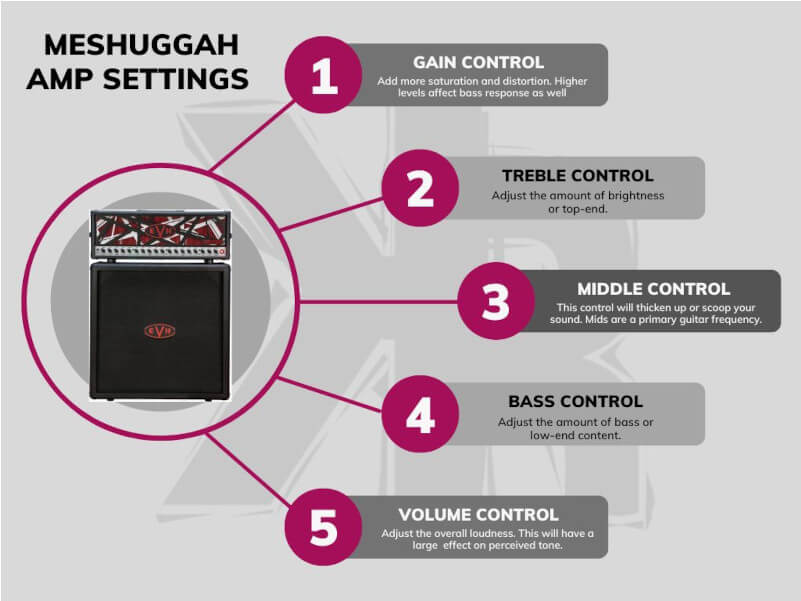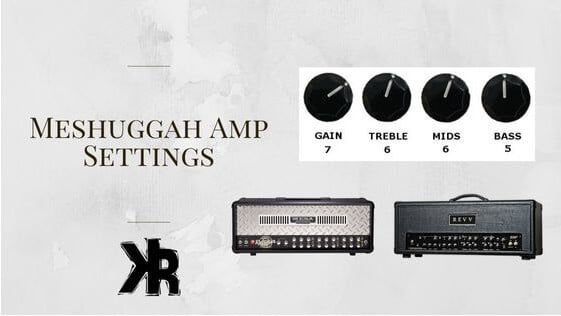Table of Contents
Few bands create the sheer sonic assault that Meshuggah does. With a sound that is both punishing and mesmerizing. They are one of the most innovative metal bands in the world.
Part of what makes their music so powerful is the way they use distortion. Plus, the unique time signatures create a wall of sound.
This can barely be comprehended by the average listener. Let’s take a closer look at Meshuggah amp settings and see what makes them so unique.
What is the Meshuggah Sound?
The Meshuggah sound is extreme. It’s a unique form of metal that is characterized by its heavy, distorted guitars. Plus polyrhythmic drumming, and growled vocals.
This sound was pioneered by the Swedish band Meshuggah in the early 1990s. It has since been adopted by many other metal bands.
The Meshuggah sound is often associated with death metal and other extreme genres. It has also been used in a variety of other musical styles. This includes progressive and groove metal, and Djent.
Some quick Meshuggah amp settings are:
- Gain: 8.
- Treble: 6.
- Mids: 7.
- Bass: 6.
- Presence: 5.
- Depth: 6.
These settings will work best with a high-gain amplifier. One designed with a crushing tone. You want the sound to be tight in the lows and quick to respond. It’s also a bright guitar tone with a lot of cut that works well in the mix.
Try our Bullet for my Valentine amp settings here!
What Equipment Is Needed For A Meshuggah Sound?
Some of the equipment needed to get a Meshuggah sound would be:
- An amplifier that can provide a thick distortion tone that is tight. Amplifiers like the Mesa Boogie Dual Rectifier or Revv Generator MK3 are perfect. The Revv also has a noise gate that would work well for fast, responsive tones.
- A good boost pedal can also be a game changer, especially if your amp isn’t as tight as you would like. Not only can you push it harder, but the bass can be sculpted to taste.
- The speaker cab used with your amp will also be crucial to the right sound. Using V30 speakers will help get you the Meshuggah sound with the right response.
- Your guitar must also be up to the task. Meshuggah uses 7 and 8-string guitars. A down-tuned 6 may get you there, but the pickup output needs to be decently aggressive.
Meshuggah Amp Settings
If you have the gear you need to get the right tone, then learning how to use it is the next step. When setting up your amplifier, here are some key factors to keep in mind.

Gain Control Knob
This will be one of the most important settings on your amplifier. You’ll want to dial in a thick distortion that is still responsive.
Start with the gain at 8 and adjust as needed. Keep in mind that the amount of low-end will also be dependent on this setting. Too much could be muddy, so the right setting is a good balance between gain and bass.
EQ Settings
The right Equalization settings are important for this sound. Especially if you are using a boost. While Meshuggah has a deep bass tone, it doesn’t mean they just crank their EQ.
- The bass must be tailored to the sound first. Start with the bass at around 7 and then add or subtract as needed. Too much could make the sound muddy, so keep it relatively tight.
- The treble should be at around 6 to start. This will give you the right amount of cut without making the sound too harsh.
- The mids should be set next. Meshuggah uses a lot of palm muting, so you’ll want to make sure your mids are not scooped out.
If your amplifier has a presence and depth control, use these to set the overall response of the sound. These are very handy controls, especially for Meshuggah tones.
Check out our metal amp settings here once you’re done reading this guide!
Popular Meshuggah Songs And Their Amplifier Settings
Getting a feel for the Meshuggah sound is best done by listening to or playing along to their songs. Pay attention to how different the sound is between songs. But the aggression remains the same.
Bleed
Bleed has a very focused guitar sound that is fast and aggressive. They don’t have a lot of bass content in the guitar tone.
It’s set to be tight due to the fast picking and unique time signature. It also has a scooped mid-range which makes the bass setting important as you don’t want it to sound thin.
Here are some amp settings to start with for bleed:
- Gain: 7.
- Treble: 6.
- Mids: 3.
- Bass: 5.
- Presence: 5.
- Depth: 4.
Depending on your amp, a boost pedal can make a difference here. You can put more emphasis on certain frequencies. This is only possible if your pedal has some tone-shaping controls.
Clockworks
This is another one of Meshuggah’s faster songs, but with a different feel. The picking is more syncopated and the overall guitar tone is very full.
The gain should be set the same as bleed to keep the sound tight. You’ll want the bass to be around 6 or 7 to fill out the low end.
The treble can be set a little higher, around 7 or 8, as this will give the sound more bite.
The mids should be set a little higher as well, around 5 or 6. This will give the palm-muting more power without losing too much definition.
Here are some amp settings to start with for Clockworks:
- Gain: 7.
- Treble: 7.
- Mids: 5.
- Bass: 6.
- Presence: 5.
- Depth: 4.
We have some great Rammstein amp settings here!
Obzen
Obzen is one of Meshuggah’s more popular songs, and it has a unique sound. It’s slower than the previous two songs, but the guitar sound is very full. The key to this song is having a good amount of low-end content in your tone.
The gain should be set around 7 or 8 to get the right amount of distortion. The bass should be cranked up to around 8. This will give the low-end the power it needs without losing its definition.
The treble can be set a little lower, around 5 or 6. This will help keep the sound full without making it too harsh, but give it a grind.
Here are some amp settings to start with for obzen:
- Gain: 7.
- Treble: 5.
- Mids: 6.
- Bass: 8.
- Presence: 5.
- Depth: 6.
The mids are also important to the sound of this song and should be set to around 6. But experiment with your amp until you have a good amount of thickness.
Meshuggah Tone Tips
This sound isn’t easy to get without the right gear. But if you have it and still can’t make it sound right, here are a few tips to help.
- Make sure the electric guitar matches the style. You can’t get Mushuggah tones with a Fender Stratocaster, no matter how hard you try. I suggest a seven-string guitar with hot pickups, maybe something from Ibanez.
- Changing the thickness of your strings can also help get you to a more aggressive tone. Thicker strings not only sound heavier, but they also add sustain to the notes.
- The amplifier must be designed for this music type. If it’s not a high-gain amp, then you will need help to get the right tones. A tight amp will always rule supreme here.
- If you’re sounding a bit thin, don’t forget about the controls on your guitar. You can adjust the tone knob to help shape your sound.
- If you don’t have a good boost for metal tones, it’s a good idea to invest in one. If you already know you like metal music, then a boost will be needed for most styles.
Conclusion
Getting the Meshuggah sound isn’t easy, but it’s possible with the right gear. These are awesome-sounding tones, especially when they come together for you.
These tips should help you get started, just don’t give up! Make sure to try different pieces of gear, there are a lot of great options available. Check out our website, we have a lot of great suggestions!
FAQs
What guitars does Meshuggah use?
The band uses a variety of electric guitars, but the most popular choice is an Ibanez eight-string. The M8M is the go-to guitar for Fredrik Thordendal for good reason.
What amps does Meshuggah use?
The band has used many different amps including, EVH, Mesa Boogie, and even Randall. The Fractal Axe-FX is also popular with the band for the versatility it offers.
Do I need a seven-string guitar to get Meshuggah tones?
No, but it will make it easier. A six-string can work, but you’ll have to tune it down to get the right sound. A seven-string will give you more options for notes and help you get the right tones.

